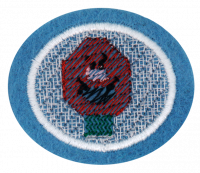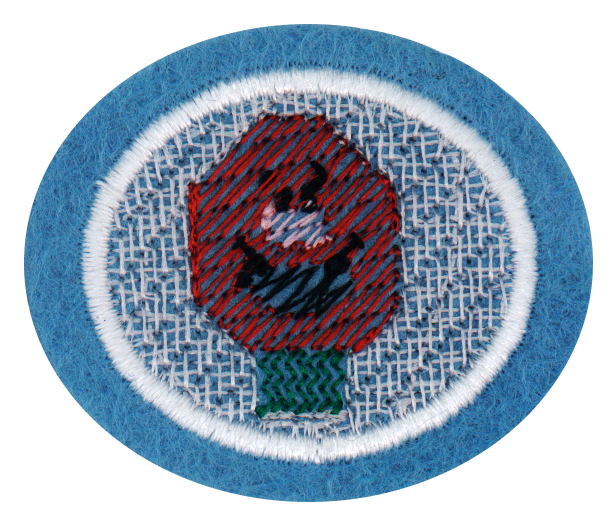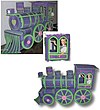Difference between revisions of "AY Honors/Plastic Canvas/Answer Key/es"
(Created page with "<noinclude>") |
(Created page with "Especialidades JA/Tejido en malla plástica/Respuestas") |
||
| Line 69: | Line 69: | ||
{{clear}} | {{clear}} | ||
| − | + | <noinclude></noinclude> | |
| − | <noinclude | ||
| − | |||
{{CloseReq}} <!-- 4d --> | {{CloseReq}} <!-- 4d --> | ||
{{ansreq|page={{#titleparts:{{PAGENAME}}|2|1}}|num=4e}} <!--T:35--> | {{ansreq|page={{#titleparts:{{PAGENAME}}|2|1}}|num=4e}} <!--T:35--> | ||
Revision as of 21:48, 5 May 2021
Nivel de destreza
1
Año
2006
Version
22.11.2024
Autoridad de aprobación
Asociación General
1
2
On the project pattern you will find that the plastic canvas grid is either counted out by using the terms lines or threads or by holes or squares. You can find the following four sizes:
- 5 holes to the inch
- 7 holes to the inch
- 10 holes to the inch
- 14 holes to the inch
3
The best type of yarn to use is regular worsted weight yarn. It is inexpensive, comes in many colors, and is widely available.
4
4a
4b
4c
4d
4e
Pearl cotton, Perle cotton, or French cotton perlé is an S-twisted, 2-ply thread with high sheen, sold in three sizes or weights (No. 3, 5, and 8, with 3 being the heaviest).
4f
Embroidery floss or stranded cotton is a loosely twisted, slightly glossy 6-strand thread, usually of cotton but also manufactured in silk and rayon. Cotton floss is the standard thread for cross-stitch. Extremely shiny rayon floss is characteristic of Brazilian embroidery.
Use in 14 point canvas.
5
Various manufacturers make Metal Plastic Canvas Needles, also called tapestry needles. You need needles that have a large eye for the yarn and they do not need to be sharp. Most plastic canvas needles are quite short.
7pt plastic canvas takes a #16 metal tapestry needle. 10pt takes a #18 needle
6
First you need a good cutting board (paper cutter), something most schools have, for the straight lines. A pair of sturdy scissors is useful for shorter segments and around circles.
7
Template:Adventist Youth Honors Answer Book/Problematic requirement This requirement is an excellent opportunity for the Pathfinders new to Plastic Canvas to learn and practice a variety of stitches and prepare the Pathfinders for the other practical projects in the honor. Other needlepoint type honors use similar stitches, so the skills are very transferable.
The requirement says "one-inch sample" which if interpreted as a single row is between 2 and 7 individual stitches in 7 point canvas. This is not an adequate number of stitches to learn any stitch and does not cover how to connect the rows of stitches side by side or how to transition to the next row. Instead, we interpret the requirement (and strongly recommend) that a sample 1 inch by 1 inch square of each stitch (except as noted) be prepared by each Pathfinder in the form of a sample canvas. The finished sample canvas will give them a quick reference guide to keep with their plastic canvas kit. The one inch square or length is actually a good rule to enforce as it trains the Pathfinder to count stitches on the project, another important skill.
After some testing, we suggest this procedure:
- Prepare strips of 7 point canvas that are are ideally at least 12 inches long and 2 inches wide. We found canvas sheets that are a little larger then a letter size sheet of paper (10.5 inch/26.7 cm x 13.5 inch/34.2 cm) that can be cut the long way.
- Each Pathfinder should create a sample canvas of a 1 inch square block of each of the listed stitches working to the edge of the canvas
- Add samples of the edge stitches (where one inch samples will do).
- Add labels (stickers or stitched) below each stitch sample.
A good resource showing all these stitches complete with videos and diagrams.
Tent stitch is a small, diagonal embroidery stitch that crosses over the intersection of one horizontal and one vertical thread of needlepoint canvas forming a slanted stitch at a 45 degree angle. It is also known as Petit point and Needlepoint stitch and is one of the most basic and versatile stitches used in needlepoint and other canvas work embroidery.
Tent stitch variants
There are three types of tent stitch, all producing the same appearance on the front of the canvas but each worked in a slightly different way and having particular characteristics, uses, benefits and drawbacks. These variants of tent stitch are known as basketweave, continental and half cross tent stitches:
- Basketweave tent stitch
The basketweave form of tent stitch is worked in diagonal rows up and down the canvas. The yarn on the back of the canvas has a typical basketweave appearance, with alternating horizontal and vertical stitches. Basketweave is the best stitch to use for covering large areas of canvas as it does not distort the canvas as the other two forms of tent stitch do.
- Continental tent stitch
Continental stitch is worked from right to left across the canvas. It's primary use is for working a single row of stitching but may be worked in multiple rows if necessary. It can also be used for stitching vertical lines. It is normally used for working a single line or for filling very small areas because of the tendency of the stitch tension to pull and distort the canvas ground fabric out of shape. This method uses more yarn than half cross stitch tent stitch but is more hardwearing.
- Half cross tent stitch
Half cross stitch is worked from left to right across the canvas. As with Continental tent stitch it's primary use is for working a single row of stitching but may be worked in multiple rows if necessary. It can also be used for stitching vertical lines. It is normally used for working a single line or for filling very small areas because of the tendency of the stitch tension to pull and distort the canvas ground fabric out of shape. This method uses less yarn than other stitches but is not very durable as coverage on the back of the canvas is a little thin.
Bargello Technique
Bargello refers not just a stitching technique, but motifs created by the change of colors in the stitches. This section describes the vertical stitch and how it is combined with color and ‘stepping’ to create different motifs.
Examples
Image(s) created and licensed by Elizabeth Pyatt.
Vertical Stitches
Most agree that traditional Bargello pieces incorporate a series of all vertical stitches (vs. diagonal stitches). The basic unit is usually a vertical stitch of four threads, but other heights are possible.
Some Bargello pieces use only one height of stitch, but even the earliest pieces (such as chairs in the Bargello museum) combined different heights of stitches.
Stepping
Bargello patterns are formed when vertical stitches are stepped or offset vertically, usually by two threads (i.e. halfway down a unit of four threads). The patterns in the steps combined with color changes determines how the overall pattern will emerge.
Flame (Sharp) vs. Curved Motifs
If vertical stitches are stepped down quickly, the design forms sharp points or zig-zags. This type of Bargello motif is often known as "flame stitch." Flame stitch can be found on the Bargello Museum chairs.
If steps are gradual, then the design will appear to be curved. Traditional curved Bargello motifs include medallions and ribbons.
8
These are all single or double sided, mostly one dimensional objects with a design of some sort. Any of these would make a good starter project. You can cut out of plastic mat or you can buy a precut kit, often in an interesting shape. Search online for stitching patterns, look in the library for pattern books or follow the directions that came with your kit. However, feel free to be creative and personalize your project with alternate colors or other modifications for after all it is your creation.
8a
8b
8c
8d
8e
8f
9
These are all three dimensional boxes of some sort. They allow the Pathfinder to learn to attach panels together and explore three dimensions.
9a
This project is a simple four sided box, with a top with a hole for tissues and the bottom open. The sides and top represent places for the Pathfinder to follow interesting patterns or create their own design on.
9b
This should have a bottom and sides, basically the same as a box with some handles cut in the sides. Totebag kits can be purchased or follow a pattern.
9c
Most Pathfinders will not know what a floppy disk is, and sure do not need one for they were born well after floppy disks became obsolete. Floppies were removable computer storage media. A similar, and not quite obsolete item might be a business card holder or a small box to store store loyalty cards in. Basically a little box to put something rectangular in.
9d
A box with a bottom, and perhaps a lid. Again, a three dimensional box.









